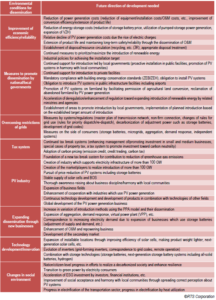With the enactment of the Acts for Establishing Resilient and Sustainable Electricity Supply Systems and the Revised Law Concerning the Promotion of the Measures to Cope with Global Warming toward the achievement of the Sixth Strategic Energy Plan and the Plan for Global Warming Countermeasures, the dissemination environment is being developed in various fields for expanding introduction of renewable energy to create a decarbonized society. The environment surrounding the dissemination of PV power generation has changed dramatically and with the introduction of the FIP scheme in FY 2022. The market has moved to a phase where power producers are integrated into the electricity market and receive a premium linked to the market price, while selling electricity on the market themselves. Under the old FIT scheme, the introduction of 60 GWAC was achieved in a short period of time due to a simple dissemination structure in which the entire amount of electricity was sold at a fixed price based on the project approval. However, in order to achieve the new introduction target of 120 GWAC by 2030, there are fundamental issues that must be overcome, such as the profitability of PV as a power source, variable power source characteristics and restrictions of grids and locations, in addition to the issue of ensuring harmony with local communities that has emerged from the rapidly expanding introduction of PV power generation. Furthermore, besides overcoming these five challenges necessary for expanding the introduction of PV power generation, it is also essential, for achieving carbon neutrality after 2030, to expand the areas of introduction through technological development, create industries that support the introduction of more than 100 GW, establish a tax system that accelerates decarbonization and changes in the social environment including social acceptance of PV power generation.
Given the short time frame to 2030 and the technologies available today, the decarbonization with renewable energy will be mainly driven by PV power generation. After 2030, considering that the utilization of PV power generation expands to the fields such as heat utilization and electrification of the transportation sector in combination with power storage technology, PV power generation will continue to occupy a core position in energy even after 2030. The environment for the dissemination of PV power generation is being enhanced by the policies which the relevant ministries and agencies are working on, however, it will be necessary to develop a multifaceted dissemination environment from now on, adding other perspectives as shown in Table 1.In particular, with regard to the PV industry, it is responsible for maintaining and reinforcing the 60 GWAC already in operation while promoting the new introduction of 60 GWAC and effectively operating the electricity generated from 120 GW under the new dissemination environment toward 2030. The PV industry needs to be fundamentally strengthened in order to create the industry capable of supporting the electricity infrastructure of more than 100 GW.
With the national target of introducing 120 GWAC by 2030 set by the government, the expanding introduction of PV power generation is showing positive signs such as follows: the installation using the PPA model; a new business model which eliminates the installation cost on the installer’s side, has started to take off; consumers have begun to take action to switch to green power and subsidies have been established for expanding introduction of PV power generation. Now is the time for the PV industry to find clear steps for growth to promote cost reduction and expand market areas, while making profit at the same time. In order to show the development vision of Japan’s PV industry, which will play a key role in achieving the ambitious installation target of 120 GWAC for 2030, the public and private sectors must come together to develop a strong strategy for the PV industry.
The USA and the European Union (EU) have begun to expand the introduction of PV power generation and strengthen the industry, including increasing domestic and regional production capacities, under the Defense Production Act and the Inflation Reduction Act of the USA and the REPowerEU plan of the EU. Japan’s PV industry must not be left behind of these trends.
Table 1 The environmental conditions for the dissemination of PV power generation with a view
to achieving the introduction target for 2030 and looking to the future after 2030

